|
"The earliest known
worked jade in Costa Rica (in the form of an
axe god) was discovered at the site
of La Regla on the Gulf of Nicoya."------1998,
Juan Vicente Guerrero M., "The Archaeological Context Of Jade In Costa
Rica," Jade In Ancient Costa Rica" p. 28.
"One of the most
typical forms of Pre-Columbian Costa Rican lapidary work is the
so-called axe-god, in which an animal, human being or a composite effigy
surmounts a celt-like polished blade."--------1998,
Michael J. Snarskis, "The Imagery And Symbolism Of Pre-Columbian Jade In
Costa Rica," Jade In Ancient Costa Rica, p. 63.
"Common in
the Costa Rican lapidary corpus are axe-gods with at first glance appear
to be avian effigies. They are in fact part of a zoo-anthropomorphic
continuum, with many jades having relative degrees of "birdness" and
"humanness."."------1998,
Michael J. Snarskis, "The Imagery And Symbolism Of Pre-Columbian Jade In
Costa Rica," Jade In Ancient Costa Rica, p. 64.
"Outstanding
among Costa Rican jades is the form long known in that country as the
dios-hacha, or axe god. The term encompasses conveniently all the
stylized figure pendants shaped as though they had been made from axes
of petaloid celts."--------1968,
Elizabeth Kennedy Easby, "Pre-Columbian Jade From Costa Rica," p.
26.
"Costa
Rican jadeite and greenstone artifacts can be divided into five basic
categories: whole celt, half celt, quarter celt, and a general category
of other forms. Most of the jade artifacts are pendants which appear to
have been produced from raw material in the form of a celt."----1988,
Mark L. Chenault, "Jadeite, Greenstone, And The Precolumbian Costa
Rican Lapidary," Costa Rican Art And Archaeology, p. 99.
"The most impressive jade pendant (found
on the Lama Corral 3 site in Costa Rica)
was a virtually three-dimensional quetzal (bird
found in Mexico to Panama) effigy axe
god"---------2013,
Michael Snarskis, "An Elite Burial Ground With Jade And Usulutan
Ceramic Offerings," Pre-Columbian Art & Archaeology, Essays In
Honor Of Frederick R. Mayer, p. 75.
"In Costa
Rica, all artifacts made from green stone have traditionally been
classified as "jade."---------1995,
Marlin Calvo Mora, Leidy Bonilla Vargas & Julio San chez Perez, "Costa
Rica, Gold, Jade, Forests," p. 77.

AXE GODS
COSTA RICA
est. 500 B.C. TO A.D. 900
Costa Rica's cultural history is recognized the
world over for its wide range of unique and skillfully crafted iconic
imagery in stone. The most famous are the large stone spheres on the
Diquis Delta that weigh up to 15 tons and the ceremonial metates, and jade
axe gods. The appearance of axe god pendants in Costa Rica
mark the beginning of a new level of social ranking and hierarchical
order. An increase in food production at this time fueled a more complex society
along with skilled artisans who produced finely crafted objects in wood
and stone for wealthy individuals. |
|
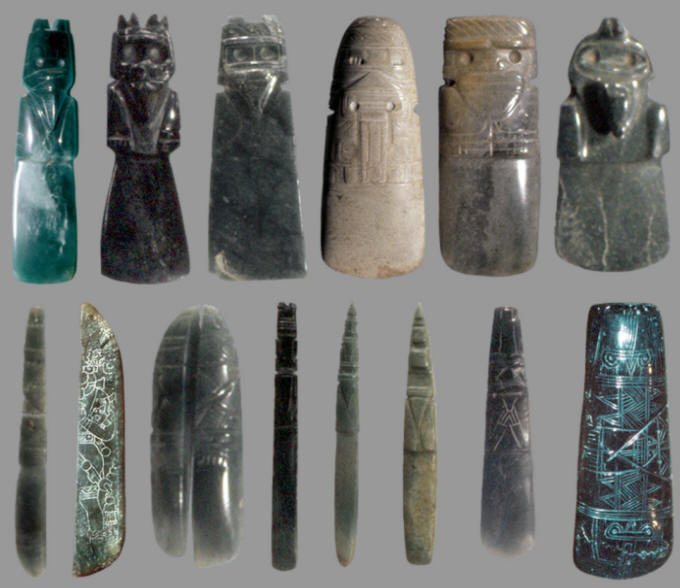
FROM LITHIC CASTING LAB'S COLLECTION OF
ORIGINAL IMAGES &
DENNIS VESPER PICTURES -- COSTA RICA NATIONAL MUSEUM
CLICK ON PICTURE FOR LARGER IMAGE
AXE GODS
COSTA RICA
est. 500 B.C. TO A.D. 900
This picture shows several different forms
of axe god pendants from Costa Rica. Most of them have both
avian and human design features. Some appear to be human forms
wearing bird masks and headdresses or a human wearing a bird
costume. Bird beaks in high relief or engraved triangles can be seen
on several of them. The half man, half bird theme is the most common
form of axe god. Most of these axe gods are made of jadeite and
drilled for suspension as a pendant.
The beige colored example in the top row is described as an
Olmecoid axe god. It represents one of the more impressive types of
axe god images that are human figures presented in serious poses.
They have human-like faces and long tongues that reach down to the
waste. It's believed that these large tongues may represent either
maize or falling water. There are some design features that seem to
originate from Olmec culture. The idea of revering and embellishing
celts originate with the Olmec hundreds of years before axe gods
were produced in Costa Rica. There may not be a direct connection
between the two cultures, but mythic legends may have preserved some
of these ideas. The Olmec produced engraved and stelae-like forms of
celts and Costa Rican craftsmen produced celts that were carved in
high-relief.
The long narrow axe gods in the bottom row relate to a unique
manufacturing process that involved cutting a celt into
multiple pieces but still maintaining each piece as a usable
pendant. Some were cut into two or more segments across the face
from top to bottom. Others were cut in quarter sections. Chenault
(1988) refers to these pieces as half celts, split celts and quarter
celts. When the process is finished, each segment of the axe god is
still recognizable in some way as a celt form. One reason for
segment cutting was to repair broken pendants.
The cut and engraved celt, in the bottom row second from the
left, is unique for the fact that it's a Mayan belt celt that was
cut lengthwise and re-drilled for suspension. Mayan belt celts (also
referred to as plaques) were worn
at the waste in a group of three in front over the loins by Mayan
kings. This example was found in Guanacaste Province, Costa Rica.
The engraving shows a portion of the king and all the elaborate
ornaments and dress he is wearing plus he holds a deity head on his
arm. These unique out-of-place artifacts may represent heirlooms
that were reworked and gifted to different individuals.
The axe god at lower right is categorized as a bat wing
pendant but its description involves crocodile, avian and maize
symbols. It was made on an unmodified celt form that was decorated
with engraving. The triangles in the center are identified as
crocodile scute symbols. The top eye design is described as both
crocodile jaws and the eyes of an avian figure. The design at the
bottom is described as a crocodile jaw hinge that becomes a
maize-plant symbol similar to examples found in Olmec iconography. |
|
|
The basic form of an axe god pendant is a celt, which
is an ungrooved axe. But they were not made from working celts, they
were made only to resemble celts. Axe gods have been found at the
neck and chest level of male, female, and child burials indicating they
were worn as necklaces and as pendants. The people who owned them were
members of wealthy and powerful families. The axe image relates
symbolically to wood clearing tools. So it's possible that the owners of
the best examples may have been heavily involved either politically or
religiously in agricultural activities. |
|
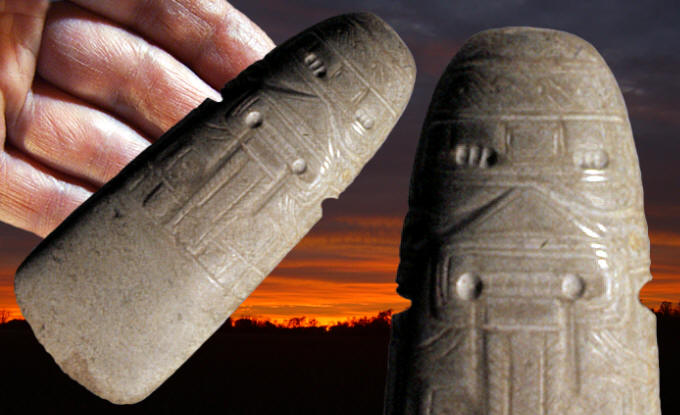
FROM LITHIC CASTING LAB'S COLLECTION OF
ORIGINAL IMAGES
OLMECOID AXE GOD
COSTA RICA
est. 500 B.C. TO A.D. 900
This impressive axe
god is described as Olmecoid. It represents one of the more impressive
types of axe god images that are presented as human figures in serious poses.
They have human-like faces and long tongues that reach down to the
waste. It's believed that these large tongues may represent either maize
or falling water. There are some design features that seem to originate
from Olmec culture. The idea of revering and embellishing celts
originate with the Olmec hundreds of years before axe gods were produced
in Costa Rica. There may not be a direct connection between the two
cultures, but mythic legends may have preserved some of these ideas. The
Olmec produced engraved and stelae-like forms of celts and Costa Rican
craftsmen produced celts that were carved in high-relief. |
|
|
Axe gods are known for their unique artistic styles,
craftsmanship, and quality of stone. Most of them were made from one
form of jade called
jadeite. Jadeite is a stone that is recognized around the world for its
color, durability and lustrous polishing qualities. Costa Rica's oldest
dated axe god is also recognized as the oldest example of worked jade in
the country. |
|
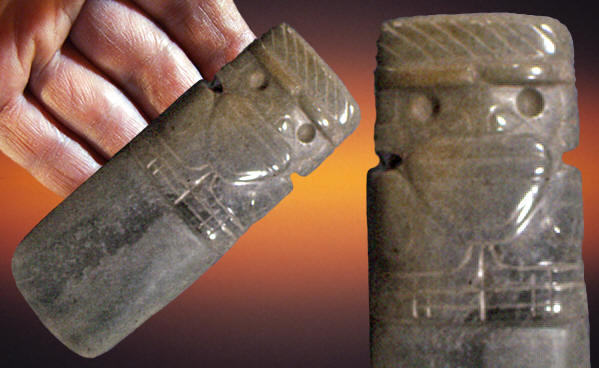
FROM LITHIC CASTING LAB'S COLLECTION OF
ORIGINAL IMAGES
AVIAN AXE GOD
COSTA RICA
est. 500 B.C. TO A.D. 900
This axe god is unique for
its wide rectangular shape. It appears to have avian features in the
form of a headdress cap and a rounded "beak." |
|
|
Axe gods are one of the most common forms of carved
stone images in Costa Rica. The earliest example dates to 2500 years
before present. It was found during the excavation of the La Regla site
in the northwestern part of the country. Archaeologists excavated
sixteen burials in 1989, 90 and 91. The site was actually flooded
most of the time because it was located in a tidal zone on the gulf of Nicoya. Other artifacts found there were two carved wood sticks, 154
small wood beads, a stone metate and six pearls. |
|
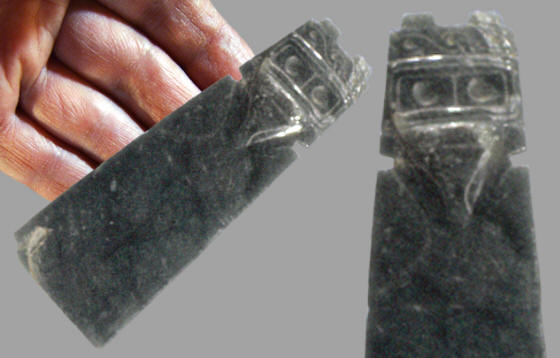
FROM LITHIC CASTING LAB'S COLLECTION OF
ORIGINAL IMAGES
AVIAN AXE GOD
COSTA RICA
est. 500 B.C. TO A.D. 900
This avian style axe god
pendant is carved in high relief. The head is accentuated by notches cut
at the neck. The headdress is nicely decorated with a scrollwork design.
The eyes are heavily framed with raised ridges and the beak is the most
impressive raised feature. But the eyes project its greatest strength. A
unique aspect of this pendant is the straight bit, which are normally
rounded, at least at the edges. |
|
|
Costa Rican axe gods were in production for more than a
thousand years. The earliest example from La Regla dates to 500 B.C.
Archaeologists mark three periods for jade production in Costa Rica; the
"Initial Period" (500 B.C. to A.D. 300),
the "Florescent Period" (A.D. 300 to 700),
and the "Terminal Period" (A.D. 700 to 900).
The Initial Period has an impressive beginning with jade artifacts found
in elite burials along with ceremonial metates, maces and bichrome
ceramics. The highest production of jade artifacts occurs during the 400
year long Florescent Period when an expanding trade with areas to the
north in Honduras and El Salvador were established. The 200 year long
Terminal Period represents the beginning of the end for quality jade
artifact production. The items that were produced at this time are not
as well made, generally smaller, made of less attractive stones, and
fewer in number. |
|
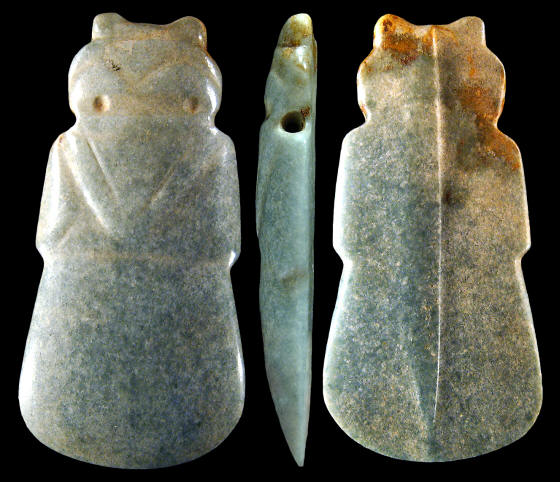
CLICK ON PICTURE FOR LARGER IMAGE
AVIAN AXE GOD
COSTA RICA
est. 500 B.C. TO A.D. 900
This axe god is illustrated
in three views. The frontal design is strictly avian and human. The
topknot headdress and "beak" are strong bird images. The bent arms may
indicate a human aspect to the design. The edge view illustrates how
most axe gods are drilled, from edge-to-edge, for suspension. The back
view is typical of most axe gods. It shows a center septum line marking
where sawing stopped from both sides before the two pieces of stone were
snapped apart. This axe god is made of jadeite and it measures 3 5/8
inches (9.3 cm) long. |
|
|
The words jade and greenstone are often used generically to
represent many different types of stone. In Costa Rica jade has been
used in a way that often encompasses a wide range of stone, such as,
serpentine, chalcedony, sandstone, tufa, lava and diorite. But the
word jade is used most often in the world to represent either jadeite or
nephrite. Jadeite is the harder of the two stones that were once thought to be the same. The only type
of jade that was used in Costa Rica was jadeite. The only recognized
source for jadeite in Central America still seems to be from Guatemala's Motagua River Valley. Although there are "never-ending rumors" and
personal accounts of discoveries of other sources in northwestern Costa
Rica on the Santa Elena Peninsula in the province of Guanacaste.
Analysis of jadeite samples from Costa Rica indicate that "with few
notable exceptions jadeite artifacts are compositionally distinct from
those of the north." The "multiple source" hypothesis for jadeite in
Central America seems to be the most logical explanation.
In-other-words, there is a high probability that another source of
jadeite does exist in Costa Rica. |
|
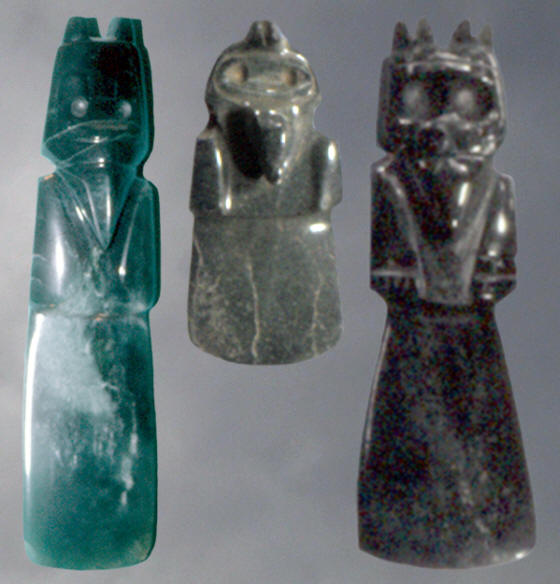
FROM LITHIC CASTING LAB'S COLLECTION OF
ORIGINAL IMAGES
AVIAN AXE GODS
COSTA RICA
est. 500 B.C. TO A.D. 900
These axe god pendants are
impressive for the fact that they were carved in high relief to
accentuate their mainly bird design features. The topknot headdresses,
extended beaks and wings combine to project a strong avian image. Very
little is left to indicate a human aspect to the design. |
|
|
Pre-Columbian cultures
valued jade more highly than gold. Probably for it's color, hardness,
durability, lustrous polish, and mythical importance. As a mythological
belief, it's thought that the stone was associated with water, the green
of young maize plants and fertility or all things agricultural. It's
believed that the stone may have represented the basic vital force of life. |
|
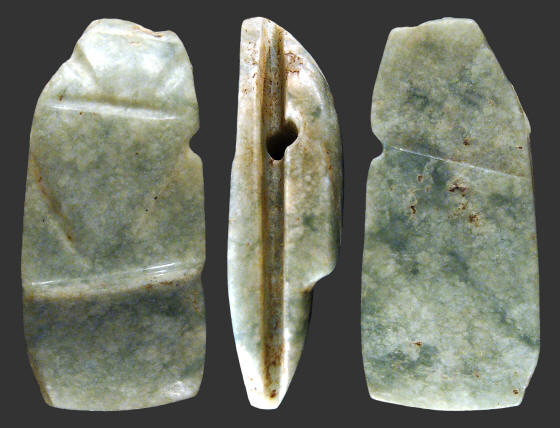
CLICK ON PICTURE FOR LARGER IMAGE
SMALL AVIAN AXE GOD PENDANT/BEAD
COSTA RICA
est. 500 B.C. TO A.D. 900
This small representation
of an axe god appears to be a remnant fragment that was finished more as
a bead than a pendant. The front side has and avian "beak" design that
is typically seen on a large percentage of normal size axe gods. The
back side is smooth except for a saw line ridge marking where the sawing
processes met from both ends. One edge is interesting for a deep cut
groove that remains from some previous manufacturing project. This
small axe god is made of jadeite and it measures 1 5/8 inches (4.1 cm)
long. |
|
|
There are several different styles of axe gods. Some
are purely human forms while others have various animal traits, such as
bat or feline. But the most common forms have an avian appearance mixed
with different levels of "humanness." Some appear to be human forms
wearing bird masks and headdresses or a human wearing a bird costume.
The half man, half bird theme was recognized over a wide area in the
Americas. A statue of an Aztec eagle warrior was found at Tenochtitlan
that depicts a human dressed in an eagle costume. The warrior is looking
out the open beak of the headdress. The lower beak forms a triangle
under the head which is a shape that is often engraved under the head
area on axe god pendants to
represent an avian trait. Even as far north as the Cahokia Mounds site
in the central Mississippi River Valley, people were depicting a human
dressed in a bird costume. |
|

FROM LITHIC CASTING LAB'S COLLECTION OF
ORIGINAL IMAGES
AVIAN AXE GODS
COSTA RICA
est. 500 B.C. TO A.D. 900
Both of these
axe god pendants have a long and narrow shape that may indicate they
were cut from a larger celt. Their triangular "beaks" put them in an
avian design category. But their main feature are the high pointed
headdresses that also may relate to bird designs. |
|
|
The most impressive axe god types are those
representing human figures presented in serious poses. Some have clearly
defined arms and carved legs. Other examples have human-like faces and
long tongues that reach down to the waste. It's believed that these
large tongues may represent either maize or falling water. Some of them
have design features that seem to originate from Olmec culture. In fact,
the idea of revering and embellishing celts originate with the Olmec
hundreds of years before axe gods were produced in Costa Rica. There may
not be a direct connection between the two cultures, but mythic legends
may have preserved some of these ideas. The Olmec produced engraved and
stelae-like forms of celts and Costa Rican craftsmen produced celts that
were carved in high-relief. |
|
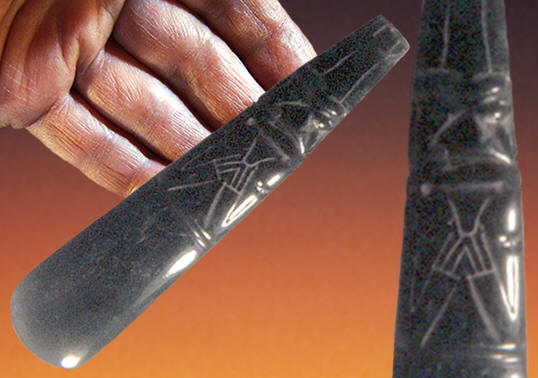
FROM LITHIC CASTING LAB'S COLLECTION OF
ORIGINAL IMAGES
OLMECOID AXE GOD
COSTA RICA
est. 500 B.C. TO A.D. 900
Olmecoid axe god pendants are described as comparatively rare in
Costa Rica. The main features on this example are the headdress cap,
the well represented arms and hands and the triangular tongue. |
|
|
Jade axe god pendants were not cut and shaped in the
same way softer stones were, with hammerstone pecking. The problem with
jadeite jade is that it's almost as hard as quartz and any type of
primitive manufacturing process is labor intensive. Costa Rican
craftsmen worked jade by sawing, abrading, drilling, and polishing. The
sawing process is actually an abrading process that was done with water
and quartz sand. Sawing was done with either a cord or a piece of stone
or wood. Cord
sawing involved a cord made of either plant fibers of animal hide that
was mounted on a wood bow. A water lubricated cord and abrasive quartz
sand produced the "sawing" process that cut the jade. A hand-held piece
of stone or wood applied in the same way will also cut or "saw." The drilling
process is believed to have been done with a simple pump drill with
either a stone bit for solid drilling or a piece of cane or bone for
tube drilling. A hollow bone drill bit is reported to have been found in
the bore of a stone plaque near Chalco, Mexico. Polishing is simply
described as using fine abrasives or various rubbing surfaces. Jade
working processes are generally best-guess descriptions. For example, no
ancient pump drill has been found in Costa Rica but it's likely they
were used in the drilling process. |
|
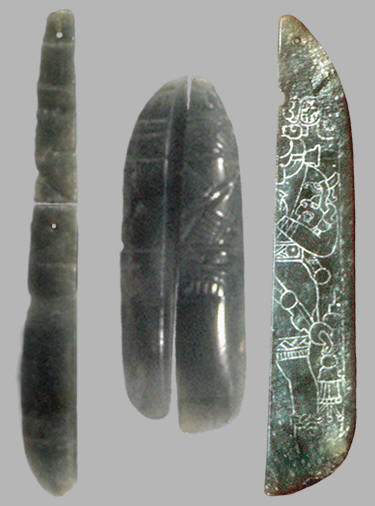
FROM LITHIC CASTING LAB'S COLLECTION OF
ORIGINAL IMAGES &
DENNIS VESPER PICTURES -- COSTA RICA NATIONAL MUSEUM
CUT CELTS
COSTA RICA
est. 500 B.C. TO A.D. 900
These long narrow and obviously vertically cut celt pendants relate to a
unique manufacturing process that involved cutting a celt into
multiple pieces but still maintaining each piece as a usable
pendant. Some were cut into two or more segments across the face
from top to bottom. Others were cut in quarter sections. Chenault
(1988) refers to these pieces as half celts, split celts and quarter
celts. When the process is finished, each segment of the axe god is
still recognizable in some way as a celt form. One reason for
segment cutting was to repair broken pendants.
The cut celt on the right is unique for the fact that it's a
Mayan belt celt that was cut lengthwise and re-drilled for suspension.
Mayan belt celts or plaques were worn at the waste in a group of three
in front over the loins by Mayan kings. This example was found in
Guanacaste Province, Costa Rica. The engraving shows a portion of the
king and all the elaborate ornaments and dress he is wearing plus he
holds a deity head on his arm. These unique out-of-place artifacts may
represent heirlooms that were reworked and gifted to different
individuals. |
|
|
Some axe gods went through a unique manufacturing process
that involved cutting them into multiple pieces but still maintaining
each piece as a usable pendant. Some were cut into two or more segments
across the face from top to bottom. Others were cut in quarter sections.
Chenault (1988) refers to these pieces as half celts, split celts and
quarter celts. When the process is finished, each segment of the axe god
is still recognizable in some way as a celt form. One reason for segment
cutting was to repair broken pendants. But examples of segmented pieces
of unbroken and engraved pendants have also been found. |
|
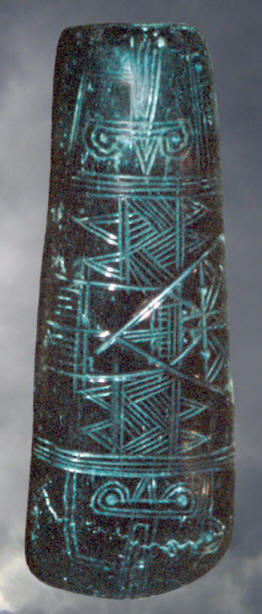
DENNIS VESPER PICTURE -- COSTA RICA
NATIONAL MUSEUM
BAT-WING AXE GOD PENDANT
GUANACASTE PROVINCE, COSTA RICA
This axe god is categorized as a bat wing pendant but its
description involves crocodile, avian and maize symbols. It was made
on an unmodified celt form that was decorated with engraving. The
triangles in the center are identified as crocodile scute symbols.
The top eye design is described as both crocodile jaws and the eyes
of an avian figure. The design at the bottom is described as as a
crocodile jaw hinge that becomes a maize-plant symbol similar to
examples found in Olmec iconography. |
|
|
Axes gods were power
symbols among the wealthy elite. Many of them still project an aura of
power. Unfortunately, only a small number of them were accurately
recorded. Most axe god pendants were found either accidentally or dug
for plunder. Ninety-nine percent of all Costa Rican jade artifacts that
were found scientifically are connected to funerary remains. If they
could only speak, what tales they would tell. |
|
"REFERENCES"
1968, Easby, Elizabeth Kennedy,
"Pre-Columbian Jade From Costa Rica."
1988, Chenault, Mark L., "Jadeite, Greenstone, And The Precolumbian
Costa Rican Lapidary," Costa Rican Art And Archaeology.
1992, Graham, Mark Miller, "Art-Tools And The Language Of Power
In The Early Art Of The Antlantic Watershed Of Costa Rica,"
Wealth And Hierarchy In The Intermediate Area.
1995, Mora, Marlin Calvo, Vargas, Leidy Bonilla & Perez, Julio
San chez, "Costa Rica, Gold, Jade, Forests."
1998, Guerrero M., Juan Vicente, "The Archaeological Context Of Jade
In Costa Rica," Jade In Ancient Costa Rica.
1998, Snarskis, Michael J., "The Imagery And Symbolism Of Pre-Columbian Jade In
Costa Rica," Jade In Ancient Costa Rica.
2010, Evans, Susan Toby & Webster, David, L., "Archaeology Of
Ancient Mexico And Central America An Encyclopedia."
2013, Snarskis, Michael, "An Elite Burial Ground With Jade And Usulutan
Ceramic Offerings," Pre-Columbian Art & Archaeology, Essays In
Honor Of Frederick R. Mayer.
|
|
RECENT
LISTINGS HOME
ORDERING |